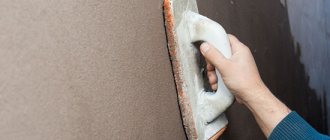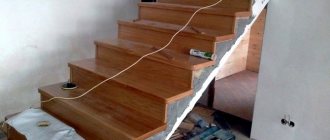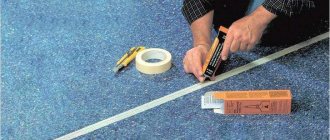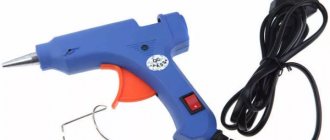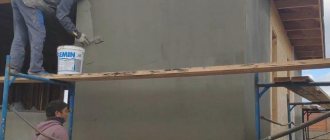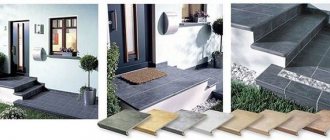When laying new linoleum, it is not necessary to contact specialists; you can handle this work yourself. The main difficulty lies in joining several strips in a large room, the size of which exceeds the width of the canvas, or at the border of rooms. If you do not pay proper attention to the seams, dirt and moisture will get into them, the material will lift up, and the appearance of the floor will deteriorate. But if you know how to glue linoleum together, this problem will be solved once and for all.
Using double-sided tape
Gluing linoleum joints with double-sided tape is a quick, simple and cheap way, but with a short-lived effect. This option is suitable for lightly loaded or temporary connections. It will not be possible to reliably join a felt or fabric-based coating using this method.
A seam glued with tape will most likely not last long; the main danger for it is moisture that will get into the joint when washing the floor.
Procedure:
- The base is cleaned of dirt and dust and treated with strengthening primer.
- The parts of the coating are carefully joined.
- Tape is glued to the floor along the joint line. Then the top protective film is removed from it and covered with linoleum.
- The edges of the material must be pressed tightly, and then the seam should be rolled with a hard roller.
What tape is used to fix linoleum
Scotch tape is a tape on which an adhesive substance is applied on both sides. To make the tape easy to unwind, one of its sides is covered with wax paper.
Depending on the base, there are three types of construction double-sided tape:
- based on polypropylene;
- on a fabric basis;
- on a foam basis;
- based on acrylic foam.
Fixing the material with double-sided adhesive tape
Overhead connection
Joining linoleum at home can be done using overhead thresholds. They have an affordable price, they are easy to choose by color and composition (plastic and metal products are found). The thresholds have ready-made holes for self-tapping screws. The connection is reliable and durable.
The process consists of several stages:
- Using a jigsaw or a metal file, cut the strip to the required length and apply it to the joint of the linoleum. Holding the threshold, mark the exit points of the screws.
- A 6mm drill is inserted into the drill and holes are made according to the markings. Dowels must be inserted into them immediately.
- The threshold is applied to the surface and secured with self-tapping screws.
USEFUL INFORMATION: 3D floors in the bathroom and toilet: 9 photos, price, technology
This method of joining the edges of linoleum is simple, but has its own peculiarity. The strip screwed to the floor stands out noticeably above the surface, so such a threshold looks good only in interior openings.
Advantages and disadvantages of felt linoleum
The main advantage of this material can be considered the low cost for quick floor insulation. In addition, due to the thick layer of coating, it can be laid on a base that has a slight difference in height.
Felted wool is a good insulator
Additionally, the advantages of felt linoleum include:
- Variety of designs and colors;
- Softness of the floor to the touch;
- Affordable price range;
- Easy installation;
- Resistance to mechanical damage;
- Possibility of laying on uneven ground.
Along with the positive qualities, the coating also has disadvantages:
- Do not install in high traffic areas;
- It is not recommended to use in rooms with high humidity, as mold may form.
This fabric is easy to install.
These disadvantages are completely compensated by advantages. The affordable cost and other positive qualities of felt-based material completely cover the existing disadvantages.
Bonding with mastic
Mastic is one of the most popular adhesives. It makes it easy to glue linoleum at home. The method is reliable, it connects “tightly”, but if you need to remove the coating for a while, then the linoleum will tear in the place where the mastic was used. It is also easy to attach the raised piece this way.
Work order:
- Before gluing the joints, prime the base.
- The edges of the coating are degreased with any alcohol-containing product. Acetone or solvents cannot be used, as they can corrode the linoleum.
- As soon as the base has dried, you need to apply a small amount of mastic to it with a spatula.
- Then the edges of the linoleum are applied to the surface and pressed tightly. The joint must be carefully rolled with a hard roller.
The mastic dries for about a day, so during this time the area where the coating has been treated needs to be pressed firmly with something heavy. A board is placed on the joined edges, and a load is placed on it.
Required Ingredients
Surely, if you look carefully, most people have small pieces of old (or new, why not) linoleum. They gather dust on balconies or mezzanines, but meanwhile there are wonderful uses for this flooring. After all, you can make glue from it yourself. Moreover, doing this is no more difficult than choosing a suitable product in a construction supermarket. And the price of such a product will obviously please you, since you only need a couple of simple ingredients. Any flooring will do. For example, Tarkett or another manufacturer.
Hot welding
You can glue linoleum joints using hot welding. This is a very reliable method that allows you to create a sealed seam that practically does not stand out from the background of the surface, but it is not suitable for all types of flooring material. Hot welding can only be used for high-strength coatings; ordinary household linoleum will simply melt.
To work, you will need a hot air gun, nozzles for it, as well as several special knives. One is for creating a groove along the entire length of the seam, the second is for cutting off excess molten welding cord. The tool is quite expensive, but since it will not be used often, it can be rented.
Hot welding is performed only on coverings that are firmly glued to the floor.
Gluing procedure:
- A special polymer cord (welding rod) is inserted into the hot air gun, which will fill the seam as the material melts.
- The edges of the linoleum are firmly joined, a small V-shaped groove is cut along the entire joint, a few millimeters smaller than the cross-section of the cord.
- The resulting gap must be cleared of debris and the edges of the linoleum must be degreased with an alcohol-containing solution.
- The hot air gun is heated to the temperature specified in the instructions (usually it ranges from 300 to 500 C°).
- The tip is placed at the beginning of the groove and slowly moves along it.
- The seam is completely filled with liquid polymer, which should protrude slightly above the edges. If the cord does not melt well, the temperature increases.
- After welding, the polymer is left in the seam until it hardens completely. Then the protruding excess is removed. While the cord is still liquid, this cannot be done, since the material shrinks. If you hurry, the seam will end up with a depression. Excess polymer is removed from the joints while the product is still warm.
USEFUL INFORMATION: Technology of hot welding of linoleum: tools and materials
Bonding methods
There are several ways to connect individual pieces of linoleum together, each of which has its own advantages and disadvantages. For example, the simplest option is to glue the joints with double-sided tape. In this case, a piece of tape of the required length is glued to the floor under the material, the second protective tape is removed from it (the tape), and the linoleum itself is fixed to the adhesive side that is revealed as a result. In this case, you should not expect high quality work, since the tape will not hold two pieces of coating very well - a gap will soon form between them, into which debris will begin to fall over time, and the joint will look ugly.
Threshold for linoleum
It is best to use the cold or hot welding method . The first method is usually used at home, the second is more often used when finishing industrial premises or in fairly large and spacious rooms.
Cold welding of linoleum
The gluing of individual panels is done using a special solvent adhesive. It contains substances that seem to melt linoleum. After this mass hardens, the two sections of the coating become one.
Cold welding of linoleum
The method is convenient for use by novice craftsmen and at home, as it does not require the acquisition of special equipment or special skills. Suitable for gluing household linoleum. This is an opportunity to connect two pieces of linoleum or repair it without any special material and time costs - the process happens quite quickly, but at the same time a well-prepared seam will be barely noticeable to the eye.
Cold welding of linoleum with glue - stages
Table. Adhesives used for cold welding.
| Titles | Characteristic |
| A | This option is suitable for connecting fresh joints when laying new linoleum. The glue is quite liquid and quickly melts the surface. To avoid damaging the rest of the coating, the joint is sealed with masking tape. Otherwise, if the glue gets on the surface of the linoleum, it will melt and ruin it. The glue is applied using a needle on the cap directly into the seam. For all processes (melting and gluing linoleum) only 15-30 minutes are enough. |
| WITH | Glue with almost the same characteristics, but thicker. It is most often used for repairing materials and during re-laying of old coverings to join individual elements. In this case, you don’t need to use adhesive tape, since the glue will not spread due to its consistency. |
| T | This type of glue is rarely used, especially by beginners. However, experienced builders may prefer it. The composition is used to connect pieces of multi-component linoleum. Made from polyvinyl chloride and polyester. The joint is strong and elastic. |
Thanks to the cold welding method, the gluing process occurs quickly. You don’t need to buy special equipment, just buy a tube of the desired type of glue. After work, the connection of two pieces of material will be reliable and durable - sufficient for a household coating.
Cold welding adhesive
Attention! Glue vapors are toxic, and toxic substances will also be released from the melting linoleum. To avoid harm to health, it is recommended to carry out work in a well-ventilated room, wearing protective gloves.
Hot welding
In this case, special equipment is used for the work - a special soldering iron, which is quite expensive. It is capable of heating linoleum to critically high temperatures (up to 400 degrees). But the method is applicable only for commercial-type coatings, since other types of materials simply will not withstand high temperatures and will be irretrievably destroyed.
Hot welding of linoleum
Advice! Hot welding is the best option for joining linoleum laid in rooms where the floors experience significant loads.
Also, for work you will have to purchase additional material - a special polyvinyl chloride cord, which during operation fills the groove formed between two sections of the coating.
Hot Welding Tools
Cord for hot welding of linoleum
On a note! It is possible to carry out high-quality hot welding of linoleum only on material previously glued to the base. The procedure should be carried out no earlier than one day after laying the coating.
The completion of the work will be the removal of the protruding part of the polyvinyl chloride cord from the joint surface. It can be cut or sanded.
Hot welding of linoleum allows you to get an almost invisible seam
Sometimes the hot welding method is implemented using a conventional soldering iron. But in this case, the joint between the canvases is unlikely to turn out beautiful. The method makes sense to use only in small areas.
Sometimes a regular soldering iron is used
Cold welding
Cold welding is a method of gluing surfaces with special compounds. The technology eliminates processing with hot air. This is the optimal method for joining the edges of linoleum in an apartment. The compositions that are used for this (“A”, “C” and “T”) are selected in accordance with the type of material being joined and the size of the gap.
- If you need to glue a new coating immediately after installation, then type “A” glue is used. It has a liquid consistency, making it ideal for tight joints and goes well with soft coatings. It is inserted with a needle that comes with the tube. The seam is almost invisible.
- If the linoleum was laid a long time ago, then the edges are connected with type “C” glue. It has a thicker consistency than type “A” composition. The glue, filling the voids, reliably holds the seams together, preventing them from coming apart in the future.
- Type “T” glue is used to glue insulated PVC coverings on a felt or polyester base. It is toxic and difficult to use, used by professionals.
The gluing method using cold welding is very simple:
- The seam line is sealed with masking tape.
- Using a sharp knife, cut the tape exactly along the joint.
- Using a nozzle, glue is introduced into the gap between the edges of the coating.
- Excess welding is cut off already frozen.
What did felt give to linoleum?
Felt linoleum is less deformed.
A patent for the production of PVC material was seen by the world 150 years ago. Since that time, linoleum has not lost its popularity, despite the existing disadvantages:
- significant residual deformation;
- low ability to resist moisture;
- inability to absorb noise;
- poor protection from fire and combustion;
- low level of thermal insulation.
Linoleum with a felt base is almost completely devoid of all these negative aspects. Instead, he demonstrates:
- The deformation has become noticeably less, and all due to the elasticity and softness of the multilayer structure;
- The noticeable hardness of the coating has disappeared. Now it is springy, even if it lies on a concrete base;
- Felt-based linoleum demonstrates excellent sound insulation properties;
- The felt is impregnated with specific anti-flammable additives. This does not exclude the possibility of fire, but makes it minimal and not so large-scale.
If we summarize all this, we can say the following: linoleum on felt is a coating that retains heat well, is almost soundproof, durable and capable of maintaining a decent appearance over a significant period of use.
Storage
If the correct conditions are provided, the shelf life of such glue is unlimited. The remains of the finished glue are stored in a dark place, as the rays of the sun can have a bad effect on it. In addition, the container must be tightly closed during storage. Otherwise, the acetone will quickly evaporate and the mass will harden. Also, do not expose the glue to high temperatures - this factor contributes to the rapid evaporation of the solvent and a change in its properties. And most importantly: keep the container with glue away from fire. Acetone is a flammable substance.
Where can you glue linoleum
Before gluing linoleum, you need to choose the right coating. This material interacts with almost all floor surfaces, but there are some nuances.
Despite the compatibility of linoleum with most flooring materials, it cannot be glued with any glue. Adhesion will be strong only if the adhesive is chosen correctly.
On concrete
The material is compatible with concrete. The coating will last a long time and for at least five years. However, for this, the floor must be flat, without depressions or protrusions.
The main danger of a concrete floor is the presence of dust on it. It is this that impairs the adhesion of the glue, and the glued canvas will hold less firmly. Therefore, the main task of the master is to thoroughly clean the concrete from dust and debris.
On a wooden floor
It is less difficult to install the coating correctly on a wooden floor. It is easier to remove debris, dirt, and dust from wood, which means adhesion to it will be better.
We recommend sanding the wooden covering before laying linoleum. This will level the surface and remove the smallest imperfections.
To plywood
Plywood (PC) is a fragile material. It is not characterized by a high tendency to adhesion, so we do not recommend gluing anything to it.
But if sizing on the FC is still necessary, it must first be cleaned and dried. We recommend gluing it with a special compound or using liquid nails.
How to glue linoleum at joints: several methods
The main problem with this material is the likelihood of separation at the seams. Therefore, the master is faced with the question of how to glue linoleum at the level of its joints.
The most common method is fastening with thresholds made of plastic or aluminum. If this technique is not suitable, we recommend using hot or cold welding. However, there are alternatives to it.
Glue gun
This gluing machine is sold at any office supply or building materials store. It connects directly to the network, heating the adhesive composition.
The instructions are quite simple:
- the edges of the material are cut to the base and cleaned of dust;
- glue is filled into the gun and the tool is plugged into an outlet;
- the heated compound fills the joints;
- until it completely hardens, you can remove its remains;
The following mixtures can interact with the coating:
- A is a universal option for sealing joining strips.
- B – to restore the old coating. Effectively fills recesses and levels the surface.
- C – for industrial use. Copes with joining polyester products.
Soldering iron
An outdated method, but it is still used by craftsmen. Suitable for removing a small number of small joints.
The soldering iron heats the edges of the canvas, they melt and connect to each other. The seam created after hardening can be carefully trimmed. An unpleasant drawback is the visibility of the seam, which often differs from the color of the coating. Therefore, this method is absolutely not suitable for light-colored coatings.
Hot welding
The seam can also be welded by hot welding. This method can only be used by specialists with experience in this type of work. It is more rational to use it if you need to eliminate seams in a thick coating.
For work, prepare the following equipment:
- Construction hair dryer with heating attachment.
- Cutters or milling machine.
- Cords match the color of the coating.
- Knife for removing residues.
We recommend choosing a hairdryer with significant power. Its task will be to heat the canvas to a temperature of 500-600 degrees Celsius. This device is equipped with a special sensor for temperature control.
The canvases are glued to the base using PVA to immobilize them. A hairdryer heats up the canvas, melting the joints and connecting them to each other as they harden. It must be remembered that the method is complex. It requires skills in working with hot materials.
Cold welding
This is one of the simple and effective ways to process edges. For him, stock up on the following equipment:
- transparent glue for welding;
- knife or scissors;
- masking tape.
Masking tape is applied to the front and back surfaces. The canvases are tightly fitted to each other, filling the seam. Then the product is allowed to dry for ten minutes, and the tape is removed. The composition will dry completely only after two hours.
Adhesive mastic
Applying mastic is the easiest method to seal seams. Upon contact with air, it hardens, forming a tight and durable connection.
The paste for gluing seams is practically harmless to use, but we recommend that the craftsman wear protective gloves. It is elastic, so it is easy to seal even the smallest joints.
Overlay strip for linoleum
Linoleum does not need to be glued. It can be connected with clamping strips made of metal or plastic. This creates a more aesthetic junction between materials with different structures. For example, this option is suitable for creating a transition between it and the laminate.
Overlay strips are the most successful solution for organizing a smooth transition between rooms and from one floor covering to another. They are inexpensive, easy to fix at the joint, even without preparation. Among the disadvantages, it should be noted that such an overlay will protrude above the linoleum covering.
